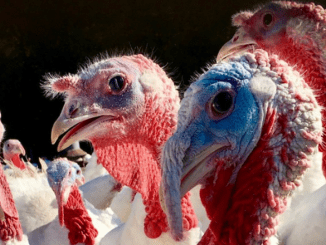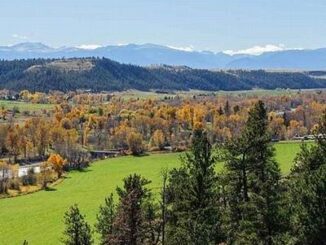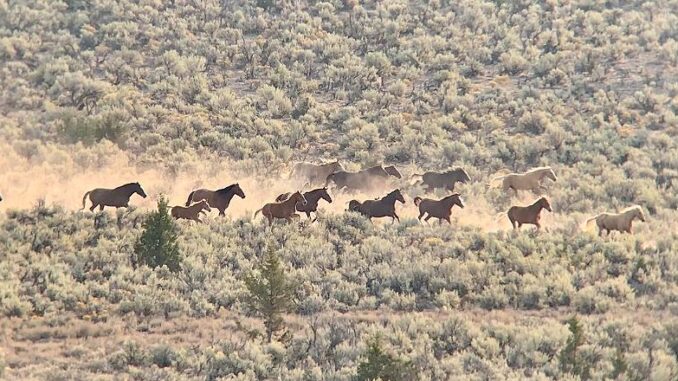
LAS VEGAS, Nevada, April 3, 2024 (ENS) – “The whir of helicopter blades deafens the peaceful swish of sagebrush. Hundreds of hooves descend upon the baking Western foothills: sweat and blood and death staining the grass for miles before the stampede is funneled into a crowded pen. Captives’ cries echo across trailer bars as close-knit families are severed in the process of transportation to feedlot-resemblant holding facilities. Heat exhaustion wracks the bodies of foals and pregnant mares,” writes wild horse activist Josselyn Wolf, 16.
“This is the reality of a wild horse roundup. This is a practice funded by taxpayer dollars. This is the secret the United States government has spent decades trying to conceal,” she writes. “This deafening truth was a shocking discovery for both me and my family.”
“Horses are quite literally the reason for my existence,” writes Josselyn. Her father, Jim Wolf, managed the U.S. Olympic Equestrian team for some 30 years and through this met her mother, a Team rider in her youth.
“Though I have always felt a deep connection with horses and all other creatures, my passions gravitate towards storytelling, particularly stories that illuminate injustice and compel people to pursue a more compassionate world. This belief in art’s profound power to enact change is exactly why I was so thrilled to meet filmmaker Ashley Avis – and so appalled by her findings,” Wolf writes.
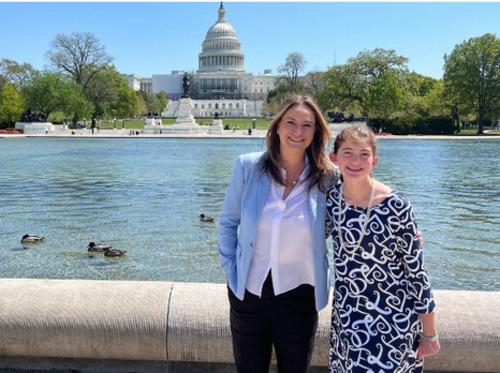
Recently introduced legislation in Congress would take what Wolf calls “the first step of rewilding” by amending the current practice of using helicopters to gather wild horses.
But the world of wild horses is a world of conflict that is intensifying as winter turns to spring.
During a meeting March 8 in Las Vegas, the Nevada Board of Wildlife Commissioners, a nine-member, governor-appointed body responsible for regulations, policy, project funding and taking public comments on wildlife, decided to sign a petition to Tracy Stone-Manning, director of the federal Bureau of Land Management, BLM.
The petition letter demands that Stone-Manning prioritize federal funds from the BLM budget to remove nearly 75 percent of Nevada’s wild horses and burros from public lands.
Dated December 2023, the petition letter originates from the Coalition for Healthy Nevada Lands, Wildlife and FreeRoaming Horses. Signed by dozens of wildlife conservation groups, as well as hunters, fishermen, trappers, and ranchers, the coalition presents itself as “advocating for Nevada’s habitat, wildlife, horses and burros.”
But what the petition letter advocates is the removal of the majority of Nevada’s free-roaming horses.
The Bureau of Land Management manages wild horses and burros on 26.9 million acres of public lands across 10 Western states as part of its mission to administer public lands for a range of uses. The BLM Wild Horse and Burro Program’s goal is “to manage healthy wild horses and burros on healthy public rangelands,” the agency states on its website.
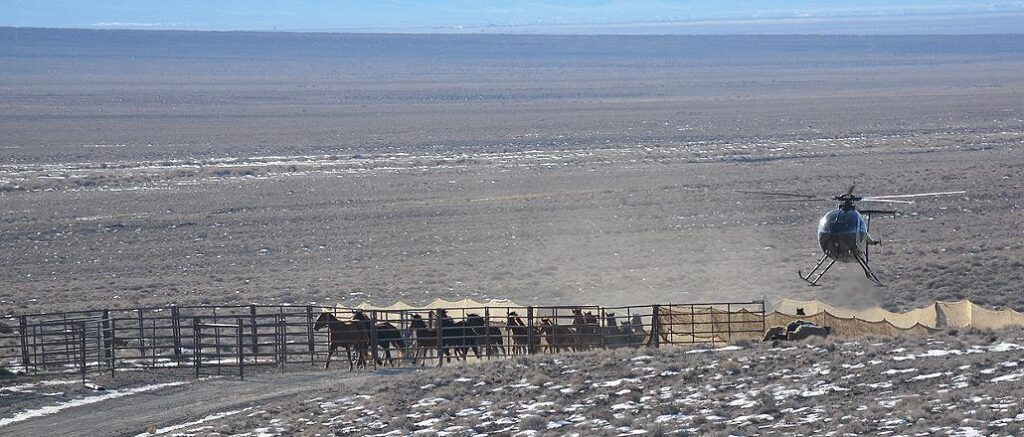
The BLM gathers and removes wild horses and burros from public lands “to protect the health of the animals and health of our nation’s public rangelands,” the agency says. In some locations, the BLM also uses birth control to slow the growth of wild horse herds. “Absent management and natural predators, wild horse herds can double in just 4-5 years and quickly outgrow the ability of the land to support them,” the agency explains.
The Coalition for Healthy Nevada Lands, Wildlife and FreeRoaming Horses and some 50 other groups that signed the petition letter argue that the population of wild horses is so large that it is damaging the land and other wildlife. They claim that there has never been enough funding for removal or sterilization of wild horses and burros to control the animals.
Coalition members argue that the water resources of the area are, “At risk of drying up due to overgrazing, trampling, and erosion from horses and burros. They worry that, “Exclusion from seeps and springs by horses and burros prevent wildlife from obtaining water, causing distress.”
“BLM’s Wild Horse and Burro Program year over year has needed more funding boosts as horse populations increase due to horses increasing their populations by approximately 20% each year,” the coalition says, adding that, “long-term overgrazing reduces carrying capacity of rangeland for future generations of horses and burros and wildlife.”
That is an opinion the Oregon Wild Horse Organization, OWHO, might agree with, but instead of seeking to gather and remove the wild horses to solve the problem, OWHO would gather and remove the livestock.
OWHO is gathering signatures on its own letter to Bureau of Land Management Director Stone-Manning. The OWHO letter represents the “undersigned taxpayers of the American public” who “urge BLM to expand efforts to effectively address the livestock overpopulation crisis on our public lands.”
Prioritizing gathering and removing livestock is the only feasible way to achieve a thriving natural ecological balance, TNEB, and save our arid public lands, the OWHO letter explains. “Inadequate management of livestock explodes populations and future budgets. Until livestock reductions are made, reducing wild horses and burros populations is not effective in management nor cost.”
The state of Oregon shares half the length of its southern border with Nevada, and OWHO, a national nonprofit organization, is so concerned about this move by its neighbor state to restrict the wild horse and burro population that members of the Oregon group spoke at the Nevada Wildlife Commissioners’ March meeting.
OWHO Vice President Janelle Ghiorso was one of the speakers. “We want the BLM and these groups to realize that they cannot make decisions for all Americans who pay for and love these public lands and wild equines,” Ghiorso said.
“Listening to them speak, it was abundantly clear to me that these people feel the state should have control of all lands within their borders, and that the federal government should not,” Ghiorso said. “They really resent anyone they consider an outsider having any say at all, even though these public lands and wild horses/burros are held in, and managed in, trust for all Americans now and in the future.”
OWHO Board of Directors President Theresa Barbour called the Coalition’s petition “horribly irresponsible.”
” I have for nearly a decade participated in administrative appeals to try to get the BLM to follow the Wild Horse and Burro Act, so we are with you in considering the letter where you ask them to follow the Act, but we obviously are asking for them to do so in a very different way,” Barbour told the Nevada commissioners at the March 8 meeting.
“When the Act was created it said that every area that had wild horses in 1971 was to be managed principally for wild horse and burro use, and we understand that’s not exclusively and obviously
other uses could be on those areas. However, the horses should have principal use of those areas,” she said.
“What we find is that the areas in Nevada that have both wild horses and livestock typically have an allocation to livestock of about 80 percent of the forage on the area. That is not giving principal use to the wild horses and burros,” Barbour said.
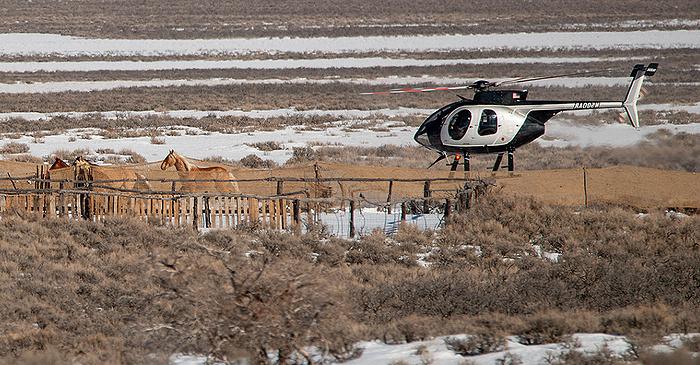
“The horses have been pushed and pushed into smaller and smaller and smaller areas. … BLM tended to create a little small area within the big area which was then called a herd management area. So the horses got pushed into these small places, and then all of a sudden BLM started screaming overpopulation.”
The wild horses are squeezed into what was left over after livestock and wildlife got their share. “That’s not an appropriate way to develop population levels,” Barbour admonished.
Barbour criticized the Nevada Board of Wildlife Commissioners for not taking into account “…the fact that most of the mares in Nevada are being treated with fertility control, which means they’re not going to increase in population each year at the same rate.”
She countered the account of a herd of starving horses that was removed from the range, by saying, “That was an isolated incident. It is not what we see coming off the range.”
“What we see coming off the range are very fat and healthy horses, and we really ask you to consider not submitting that letter the way it’s written and doing some more research,” she said.
Barbour then offered to “connect with anyone who wants to have a serious conversation with that and not just scapegoat our horses for livestock purposes or hunting or angling, because these horses are not doing the damage out there.”
But her position did not win acceptance from the Nevada Board of Wildlife Commissioners, which signed on to the Coalition’s letter petitioning the BLM to remove 75 percent of the state’s wild horses.
The OWHO letter to BLM Director Stone-Manning has signatories from all 50 states and Washington, DC, as well as from 45 tribes within U.S. boundaries and four outside. Signatures have come from 40 other countries, and the Western Watersheds Project, which specializes in western public lands issues, .
Members from 45 tribes signed on, but no tribes, as entities, signed the letter, OWHO Board of Directors President Theresa Barbour said. However, she explained, while the fact that a tribal member signed on does not mean that the whole tribe did, the organizations that are signatories are not just individuals, but “had owner or board support for the organization to sign on.”
US Tribes represented by individuals include the: Blackfoot, Navajo, Apache, Cherokee, Sioux, Ottawa, Cree, Mohawk, Pawnee, Paiute, Lakota, Arapaho, Lumbee, Odawa/Ojibwe, Haudenosaunee, Osage, Washiw (Washoe), Cheyenne, Potawatomi, Onondaga, Chippewa, Snohomish, Chemehuevi, Oyate, Hopi, Iroquois, Menominee, Calusa, Haskell, Cahuilla, Kalispel, Shoshone, Choctaw, Tuscarora, Shawnee, Powhatan, Dakota, Klikitat, Upper Umpqua, and Pueblo
Signatory Tribes outside U.S. boundaries are: eastern Canada’s Haudenosaunee Tribe; on Canada’s West Coast the Haida First Nation; in the province of Ontario, the Shawanaga First Nation; and in Canada, the Cree Nation, which lives north and west of Lake Superior.
Signatory Organizations include: Oregon Wild Horse Organization, National Treasure Mustang Rescue and Sanctuary, Wild Horse Observers Association, Western Watersheds Project, Protect the Wolf, Stop Wild Horse Roundups Coalition, Wild Horses of America, Chasing Wild Horses, Coloradans Against Horse Slaughter, Distinacion’s Therapy and Maybell’s Mission Inc., 8 Bays Learning Center and Sanctuary, Union Members for Preservation of Wildlife International, Salvation Wild Mustang Sanctuary, Red Bird Trust, Broken Arrow Equines Rescue, Connecticut Horse Defence Coalition, Citizens for Human Los Angeles, Hooves of Promise, Advocates for Wild Equine
Nations Represented by Signature Support include:
Algeria, Australia, Austria, Bangladesh, Belarus, Brazil, Chile, Canada, Denmark, East Africa, Ecuador, Estonia, France, Fiji, Germany, Greece, India, Ireland, Italy, Kosovo, Madagascar, Mexico, New Zealand, Nigeria, Norway, Panama, Philippines, Poland, Peru, Puerto Rico, Romania, Scotland, Slovenia, South Africa, Spain, Sri Lanka, Sweden, Turkey, Venezuela, and the United Kingdom.
Wild Equine Advocacy Hits High Intensity
Yet another wild horse conservation NGO, the American Wild Horse Conservation, AWHC, says the Bureau of Land Management’s 2024 wild horse and burro population estimates and its future management plans are proof of a “failed management system.”
AWHC criticized the agency for promoting mass roundups without disclosing the consequences, including 64,000 wild horses and burros confined in holding facilities and potential taxpayer costs exceeding $1 billion.
In response, the group is renewing its call to Congress to strengthen support for sustainable, in-the-wild measures to reduce removals and warehousing of wild horses in captivity.
Last week, the BLM released its 2024 wild horse and burro population estimates and the data defining this year’s gather and removal plans.
By the numbers, there are between 63,000 and 85,000 animals on the range, a figure that’s down from 2023 levels.
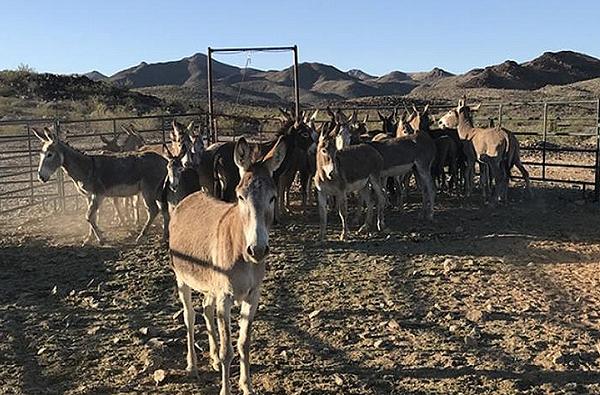
Over the last three years, the BLM has removed 50,000 of these federally protected animals from the range and intends to remove at least 20,000 more this year.
The BLM states its goal as adopting or selling 10,000 captured wild horses and burros this year, but AWHC warns that the federal agency does not disclose that its controversial cash incentive adoption program that “has sent truckloads of these iconic animals into the slaughter pipeline.”
“This is not sustainable conservation of these national icons,” Suzanne Roy, executive director of AWHC, said. “It’s time for Congress to require humane and less costly in-the-wild methods that preserve the freedom of America’s federally protected wild horses.”
Roy noted that recently published science establishes reversible fertility control darting programs as viable and effective alternatives to traumatic and costly helicopter removals.
Congress has repeatedly directed BLM to prioritize in-the-wild conservation by prioritizing fertility control, and over the last two fiscal years Congress has allocated over $20 million to support that approach.
While the BLM asserts that the agency has increased the use of fertility control vaccines, the number of treatments decreased in 2023 as compared to 2022, and the agency continues to spend just one percent of its $142 million budget on reversible fertility control program,” the AWHC argues. “Meanwhile,” the group states, “over 70 percent is spent to round up and stockpile wild horses and burros in holding facilities.”
“Continuing costly, large-scale helicopter roundups is a flawed, excessive, and inhumane policy that places an unmanageable burden on an inadequate holding and adoptions system and on U.S. taxpayers.
The program also comes at a high cost to these wild, free-roaming animals who are captured, traumatized, robbed of their freedom, and will spend the rest of their lives in captivity, or worse, will end up at slaughter plants in Canada and Mexico,” Roy said.
AWHC advocates for a new conservation approach that upholds the 1971 Wild Free-Roaming Horses and Burros Act, which protects these animals as living symbols of the spirit of the West and mandates that they be considered as an “integral part of the natural system of the public lands.”
AWHC is offering its humane conservation methods as models for in-the-wild solutions to protect wild horses and their habitats. AWHC’s land trust operates a 3,300-acre preserve in Nevada that is protecting habitat for the Fish Springs wild horse herd and abundant other wildlife. AWHC also operates three wild horse fertility control programs, including in Nevada’s Virginia Range where the effort is now the largest wild horse fertility control program in the world.
There are several forms of fertility control for wild horses and burros. The BLM primarily uses a vaccine called Porcine Zone Pellucida, or PZP, which has been approved by the U.S. Environmental Protection Agency, EPA, since 2012 for use in wild horses and burros.
The BLM is also expanding its use of a newer vaccine called GonaCon-Equine, which works slightly differently than PZP, as well as soft silicone intrauterine devices. In FY2020 the BLM increased its use of GonaCon-Equine by 75 percent.
The PZP vaccine is generally only effective for one to two years, after which an annual booster is required to keep it working. There is some evidence that GonaCon-Equine can last up to five to six years if boostered after the initial dose.
While OWHO supports on-range management using PZP, this group says that’s not what is happening on federal lands today.
“The supposed $11 million in the 2024 federal BLM budget is almost entirely for helicopter roundups and removals. A negligible amount is spent on “reversible, humane fertility control implementation,” OWHO Board President Barbour said.
Just one of the helicopter contractors, in 2023 alone, received over $7 million from the BLM for “wild horse and burro control.” Four companies – and there are more – received over $16.5 million in 2023 for wild horse and burro removals, she explained.
“Virtually all federally wild horse and burro herds are actually managed inhumanely by roundup using helicopters, not contraception or natural predators. This is where the millions of dollars per year go,” Barbour said.
“A few horses are darted off-range after the helicopter roundup and then released,” she said, calling that, “an attempt to convince people they are managing the herds with birth control. This is NOT fertility control. This is not humane. This is gaslighting.”
Barbour explained in an email to ENS, “Most federally wild horses do not live out their lives on the range. They are removed in their prime and many go to sale/slaughter. This is a meat market and a disgrace misleading the public.”
“PZP can be utilized on-range without helicopters. Further, millions of dollars are wasted each year by DOI/BLM on ‘research’ on living herds with reports never written and results not shared with the public, and horses extirpated, removed, gone,” Barbour said, about the destruction of these federally protected animals. “Though numerous studies have been completed there are seemingly no results, so the BLM continues to pay for more research, often using the same researchers.”
“The very simple solution is to follow the 1971 Wild Free-Roaming Horses and Burros Act which has never really been followed by the BLM. The Act has never been amended to state that any area, no matter what BLM has called it, will no longer be managed “principally” for wild horses and burros. Instead the BLM interpreted the Act and created implementing regulations to say that they will only follow that mandate IF they have labeled an area a Range,” Barbour said. “There remain only four such areas in the entire country.”
Feature image: In August 2021, BLM-OR/WA initiated an emergency wild horse gather at the Palomino Buttes Herd Management Area near Burns, Oregon. The horses were moved to a more abundant water source as 250 horses were able to drink at only three locations in their “use area.” August 2021. (Photo by Tara Thissell, Bureau of Land Management)
© 2024, Environment News Service. All rights reserved. Content may be quoted only with proper attribution and a direct link to the original article. Full reproduction is prohibited.

